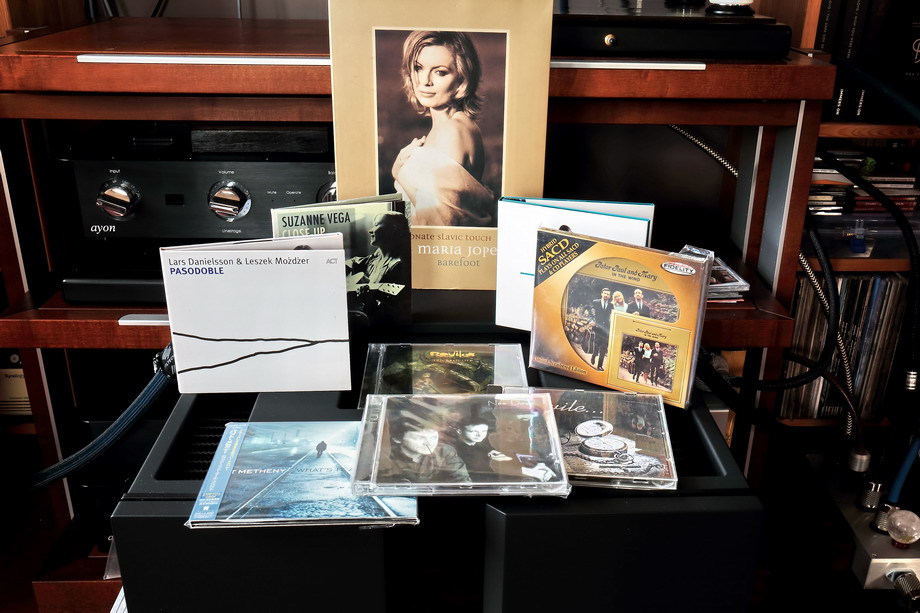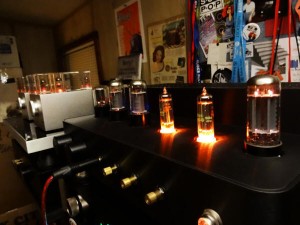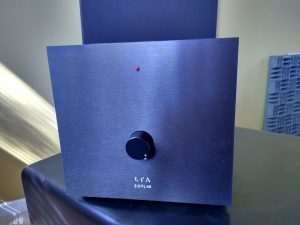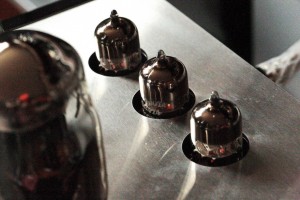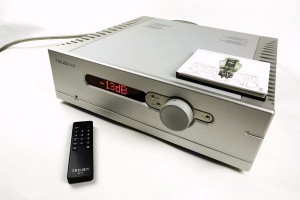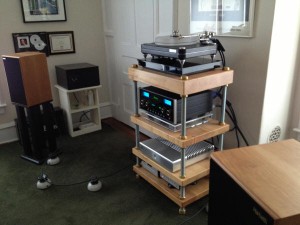PREMIERE
The first amplifier from the Danish company Vitus Audio was presented in 2003. Earlier, however, for eight years, its project was improved and perfected. Hans Ole Vitus Nielsen is the founder and head of the company, as well as its chief designer. We are testing his latest product, the SIA-030 integrated amplifier, weighing 63 kg.
The color chosen by Hans Ole Vitus Nielsen for his new integrated amplifier SIA-030 that premiered during the Munich High End Show 2019 attracted a lot of attention. The orange beast was clearly visible through the window of the room occupied by this company, which was why it worked like a magnet on people passing by. And once they came in, they couldn't leave. So it is no wonder that the device received numerous awards, including one from our magazine.
SIA-030
SIA-030 is a stereo integrated amplifier (SIA = stereo integrated amplifier), whose output stage can operate either in class A or AB. When operating in the former it delivers 30, and in the latter 200 W at 8 Ω load (the company does not provide output at 4 Ω load). This is a powerful device, which is part of the trend to build top super-integrated amps, represented, for example, by Soulution 530, Accuphase E-650 and MA8000 McIntosh.
Chassis
It's a beast—SIA-030 weighs 63 kg and it is a weight compacted into a relatively small chassis. From the outside it resembles a medium-sized air conditioner—but it tends to gives off heat rather than absorb it. Especially when it works in class A. It is a classic example of the basic principle of industrial design "forms follows function," i.e. one in which the product's form results from its functions. The amplifier is so big because of the need to disperse a lot of heat from the output transistors without the use of fans. And it is so compact to minimize vibrations as well as internal connections.
The characteristic external design was established by Hans-Ole many years ago. The chassis is made of very thick, perfectly matched black or silver aluminum plates. The front is made of two vertical panels with a black acrylic placed in the middle. In its lower part there is a display on which we can read the status of the device. Once, if I remember correctly, the display was orange, and now it is a color one, with individual colors indicating specific functions. You can change them anyway.
A lot can also be changed in the menu, because in addition to the usual adjustments, such as changing the volume and input, we can also switch between the class of operation and also select a mode. There are two ones: "Classic," with a softer sound, or "Rock"—you know what that means... . In the menu we can also change the balance between channels, input sensitivity, and even the names of inputs.
Connectivity
On the back we will find the best of the best Furutech sockets—all rhodium plated. There are five line inputs available, with two unbalanced (RCA) and three balanced (XLR) ones. The device is a fully balanced design, so the manufacturer encourages to use balanced connections. There is also a preamplifier output for those who wish to connect a second power amplifier and use bi-amping for speakers, an IEC power inlet, and a USB (type A) port to upgrade firmware if necessary. SIA-030 is a modern device, controlled by a microcomputer, which also cares about its safe operation.
Technique
The SIA-030 uses solutions developed for the top Masterpiece monoblocks, i.e. the top series of this manufacturer, the MP-M201 model, and the MP-L201 preamplifier. So we get a newly developed volume control, and the attenuator is—next to the power supply—one of the major weaknesses of audio amplifiers. Now we can adjust volume in 0.5 dB steps from beginning to end, in the range from -99 to +13 dB. This attenuator was built using precise, discrete resistors switched by relays. More important, however, is the fact that the device's power supply is fully regulated, also for output transistors.
The device can be expanded with optional modules—on the back there are two blinded slots. The first of available modules is a digital-to-analog converter and a streamer in one. The other is a MM/MC phono preamplifier with two unbalanced inputs, each separately adjustable. Both modules have been developed especially for this amplifier and are designed so that their installation can be made by everyone on their own.
The amplifier comes with the aluminum RC-010 remote.
It simply looks great!
HOW WE LISTENED TO IT
The Vitus Audio SIA-030 amplifier was assessed in the High Fidelity's reference system and compared to a set consisting of the Ayon Audio Spheris III preamplifier and the Soulution 710 power amplifier (this set costs twice as much as the SIA-030). The source of the signal was the Ayon Audio CD-35 HF Edition SACD player, connected to the Vitus amplifier using the Acoustic Revive XLR-1.5 Triple C-FM (1.8x1.4) balanced interconnect. The amplifier was powered by the Acoustic Revive Absolute-Power cable, and the signal to the speakers was sent through the Siltech Triple Crown cables.
Since the SIA-030 is extremely heavy, I placed it on a transport crate, in front of the Finite Elemente Master Reference Pagode Edition rack; the crate was filled with a material damping vibration and supporting its lid. The listening session was conducted with an amplifier working in "Classic" mode and in class A. I conducted the test alone, but we listened to the amplifier for an hour together with its creator, Hans Ole.
SOUND
Recordings used for the test (a selection)
- Anja Garbarek, Briefly Shaking, EMI Music Norway 86080226, CCD (2005)
- Anna Maria Jopek, Barefoot, Universal Music Polska 016 299-2, Promo Copy CD (2001)
- Bogdan Hołownia, Chwile, Sony Music Polska 5052882, "Pre-Mastering Version," Master CD-R (2000)
- Dominic Miller & Neil Stacey, New Dawn, Naim naimcd066, CD (2002)
- Eddie Vedder, Into The Wild, soundtrack, Sony Music 88698-18240 2, CD (2007)
- King Crimson, In The Court of the Crimson King, Atlantic/WOWOW Entertainment [Japan] IEDG-01, 7" Platinum SHM-CD + DVD-Audio (1969/2016)
- Kortez, Bumerang, Asfalt Records JB 029 2CD, CD (2015); review HERE
- Lars Danielsson & Leszek Możdżer, Pasodoble, ACT Music, ACT 9458-2, CD; review HERE; rip FLAC.
- Novika, Tricks of Life, Kayax 013 CD (2006)
- Pat Metheny, What's It All About, Nonesuch Records/Warner Music Japan WPCR-14176, CD (2011); review HERE.
- Suzanne Vega, Close-Up. Vol.1, Love Songs, Amanuensis Productions | Cooking Vinyl COCKCD521, CD (2014)
SIA-30 and Hans Ole Vitus Nielsen
First of all, I have to say that I am really impressed with the sound stage that you have here. Especially, if we take into account the circumstances, that is, problems with placing speakers in a room that also serves other household members. Regardless, the soundstage is simply unbelievable. The sound, as a whole, is very detailed, very open. I'm impressed. And I heard my amplifier in this system - it's incredibly quiet (it's about background noise—ed.).
I use several systems at my place, but my personal one is based on the amplifier you heard in Munich, the orange one, and the pair of Sonus faber Extrema speakers. For the first time I heard them in a very small room, about 10-12 m2, in a close field. If I had extended my arm I could have touch them.
It was many years ago when I listened to the speakers from so up close, but right there, with this man, I was as impressed with the soundstage as I am here. That's why I just had to buy these speakers. They are very difficult to control, but it is an extremely helpful tool for me when developing new components—your system is similar in this regard.
I also have Martin Logans, for the same reason. I have several signal sources: the Micro-Seiki DL-111 turntable, a music server and four reel-to-reel tape recorders, of which the Sony APR-5000 is the most valuable. This is a really great tape recorder, much better than Studers and Apexes, because Sony entered the market very late and from the start with very modern, advanced solutions, which the competition has not reached yet. The nice thing about it is that I can quickly change the head module from ¼" to ½".
SIA-030 and me
I was traveling recently with several of my daughter's teachers—we were returning from a Saturday trip to Zakrzów, where we collected rubbish, ate, had fun, while getting acquainted with guests from Nepal who came to school for an exchange. On the way back I sat next to a German teacher. At some point, we started to discuss differences between various people. It turned out that my interlocutor was also a simultaneous translator who regularly participated in shows of purebred dogs.
She told me about the last event she participated in, exclusively with German Shepherd breeders, that was unique. They are people who value close contact, patting each other, etc. She had never felt so accepted before, she said. It has been known for a long time that dogs become more like their owners. Now it is also known that these changes occur in dogs at the DNA level. So looking at the animal, we can most likely say what his master is like, or at least what type of man he/she is. The same may be said about audio devices and their designers.
If you have ever seen Hans Ole and at least once heard his devices, this correlation is obvious. The owner of Vitus Audio is a large, warm man, extremely communicative, honest, laid back, but with an iron spine. In a word, he is a guy who is very sensitive, but who is incredibly well composed too.
Well, let's listen to the guitar of Pat Metheny from What's It All About, or guitars of Miller and Stacey from New Dawn and we will immediately hear a large, warm, slightly rounded sound that is at the same time perfectly controlled. The guitars had a large "body," beautiful timbre and quick attack. The latter may be surprising, especially in the context of what I said about "slight rounding." But only until we realize that in this way, or very similar, we perceive live sounds. They are natural in the sense that they do not attract attention, but only allow the identification of a sound source.
There is momentum here, but also a place for an intimate dive into the music. Generally, however, the spirit of peace and relaxation hovers over everything. With subcutaneous energy, but still. This is not a "dazzling" relaxation, but one with which we know perfectly well that we are in control of everything and we do not have to do anything to prove it. That's why recordings with high dynamics, like Children of Sanchez by Chuck Mangione and those in which the bass builds the whole story, as in Tricks of life by Noviki, Silence by Aquavoice and Homeland by Laurie Anderson, they all sounded strong, dense and rich.
Bass with this amplifier goes really low and is very well controlled all the time. But to formulate this sentence I had to listen to a dozen or so discs, only from this angle. The control I am talking about is invisible, "transparent." There is no hardening of the attack or emphasizing of higher harmonics. There is a density, which in its mass is certain, punctual and provides a real foundation on which all the higher frequencies are build upon.
And the part of the band above bass is even more relaxed and the colors are even more saturated. It's safe to say that the midrange with the Vitus sounds like with some high-end tube amplifier. Medium bass is a bit more emphasized, which results in a bigger bodies of instruments also with recordings that were treated not quite fair by sound engineers. With those on which the sound is big on its own, it will simply be natural, as if the performer was standing not far from us, usually on a higher level, and sang only for one person—for us. That's how I perceived songs from the Peter, Paul and Mary's album The Wind, that's how Suzanne Vega's Close-Up Vol. 1, Love Songs sounded like.
And that's why, because the midrange is the most important here, the treble seems a bit "behind" the sound. This is a classic case in which one could claim that the sound is warmed up. But only until we realize—again—that we do not really notice the treble in everyday life, they are mainly used to determine the direction which the sound comes from. So it was also here, that is, the treble completed the midrange.
Because there is plenty of treble here. But in the sense that there is a lot of information from the top of the band. The disc I listened to to evaluated this aspect of the sound was Moments ... by Bogdan Hołownia, but in the Master CD-R version without the final mastering, because it sounded as I expected it, meaning I could hear that it was recorded in a studio, but there was also a clear image of percussion instruments. Even more obvious, what I am talking about, was with the "Barefoot" by Anna Maria Jopek, with Możdżer on a piano. It is a disc with a "emphasized" sound, more compressed, but still on the good side of things. And there was a lot of treble, but it was presented—again—rather as subcutaneous information not "details."
CLASS, MODE
There is nothing "standard" about this amplifier. When we compare the sound in class A and AB it turns out that the result are different than expected. The stereotype says that class A gives a warm, creamy sound, while class AB gives a brighter and more detailed one. And it really was so, but about 30-40 years ago! Since then, the transistor technology has matured incredibly and today we know that these were only approximations, not an ultimate goal.
The Vitus amplifier working in class A is more detailed and shows more air at the top of the band. It also differentiates the depth better, i.e. there are clearer layers and better gradation of the instruments sizes. On the other hand, AB class operation slightly emphasizes the medium and upper bass range, but also controls it better. The treble is warmer and slightly more closed in.
The differences between "Classic" and "Rock" modes are similar. I would say they are complementary to a change in operation class. But the accents are distributed differently. "Classic" is more vivid and warmer, and "Rock" more expressive, especially at the bottom of the band, but also more contouring. I liked the combination of "Classic" mode and class A operation most.
At the same time, I noticed something that the amplifier does not impose, but what makes it a part of high-end bunch. Namely, great differentiation. I mentioned earlier "tube sound," but I did not add that a large part of the warm sounding tube amplifiers fail to differentiate sound properly. Vitus SIA-030 is completely different. It shows the differences between recordings, between masterings, clearly indicating the idea behind a given sound creation.
Here, all of it is presented indirectly, the technique is never put in front of music. Because the space is big and the stage is deep. In recordings in which a "bubble" of air was created by manipulating the out-of-phase sounds, say on Roger Waters' Amused to Death or in the excellent song "People of Ice," from the Kortez' album Boomerang, we will get a powerful sound with space and reverb.
But it is not an amplifier that would emphasize spatial relations. I would even say that it focuses our attention on the foreground. And this is because it is big, which is a result of how rich it is. Interestingly, even warm voices such as Frank Sinatra's and Bill Crosby's were presented closer to me than usually. Everything was exactly on the line connecting the speakers, so there was no "enlarging" of vocals. However, I could clearly hear that the amplifier prefers what connects sound sources, while slightly weakening the air between them.
SUMMARY
All the features I discussed are presented at a very high level. It's a proper high-end device. It is also clearly a custom proposition, different from what one can hear with other amplifiers from such brands as McIntosh, Soulution, or Ancient Audio, closer to what—for example—Dan D'Agostino and Kondo propose. I do not distinguish tube and solid-state devices on purpose. Each of them has something special to offer, but in top high-end class they have more in common than you might think.
The SIA-030 is relatively small by super-integrated standards, and yet it executes a perfect control over speakers, not only when in AB class, but also in the A class operation. The AB class allows you to play in large rooms with difficult speakers. But class A is more natural and credible. And that's good—this is about choice. Because SIA-030 is a fantastically equipped integrated amplifier with beautiful sound. It's the best integrated amplifier, maybe next to the Soulution 530 I've ever heard. Our highest GOLD Fingerprint award is just a formality, despite the fact that the SIA-030 is one of the cheapest (!) amplifiers from this manufacturer.
DESIGN
SIA-030 is a stereo integrated amplifier, that belongs to the "Signature" series. The company offers its components divided into four series. It starts with "Reference," then there is "Signature," then "Masterpiece," and finally "Design Studio Series." Products from the latter have not yet been presented, it's a project that have been developed for many years by Hans Ole and once ready the components from this line will be produced upon order.
Technique
I described the appearance of the tested amplifier in the introduction, now let me just add that the sides of the device are actually huge heat-sinks. PCBs with output stages and transistors are bolted to the heat-sinks on the inside In this way, the left and right channels are far apart, which reduces crosstalk. As many as six complementary pairs of transistors work there, but not all of them operate in the same way. As the owner of Vitus told me, this is his original idea, which took him ten minutes to come up, and then a year to implement.
The difference I'm talking about is part of the idea for two modes of operation—"Classic" and "Rock." In the former the amplifier works with only one complementary pair of transistors per channel. This simplifies the design and counteracts the creation of a feedback impulse from the transistors (transistors inside the housing resemble a coil, and the coil's characteristic feature is that after we feed it a signal, some of it goes back towards the source). The other two pairs operate as a trans-impedance section, or current source. After switching to the "Rock" mode, which takes several seconds, before the parameters of the transistors are established, they are configured as a classic push-pull amplifier with three parallel pairs of transistors. And that's the whole secret. Let's add that these are bipolar transistors, complementary pairs of 2SA1216 + 2SC2922.
To reduce the signal path's length the attenuator and preamplifier board, together with the input selector, were screwed directly to the back panel and the input sockets were soldered to it. To isolate the preamplifier section from the fields generated by the power supply and output stage, it was closed in the screen. The whole is a closed section, separated from other circuits.
Power supply
When we look inside, a giant double C power transformer will draw our attention. Transformers of similar design are also used by YBA, but I've never seen them as large as here—it is a 2.2 kW unit. It is set on lossy elements that are to minimize its vibrations. It works with a bank of large capacitors suppressing network ripples, eight pieces, four per channel. The power supply features separate secondary windings for the left and right channels. What's more, there is also a separate, advanced power supply for controlling and auxiliary systems. The total capacity of the capacitors in the preamplifier is 400,000 μF, and in the output stage its 216,000 μF.
According to the manufacturer the power supply is fully regulated, including the output stage. This solution was sourced from the Masterpiece MP-M201 monoblocks. Regulating an output stage is a difficult task and only few companies succeed, including Naim in their amplifiers, such as the Statement.
The power supplies are assembled on a thick aluminum plate that additionally stiffens the device chassis. The exact internal structure can be seen in the report posted on the audioFi.net website (HERE, accessed 09/17/2019). Let's add that the amplifier is delivered in a large box made of plywood and wood.
Precision, perfection, top performance.
Technical specifications (according to manufacturer)
- Nominal output (class A/class AB): 30/200 W/8 Ω
- Frequency range: DC-800 kHz
- Input sensitivity: 2/4/8 Vrms
- Input impedance (RCA | XLR): 10 kΩ | 10 kΩ
- S/N ratio: > 120 dB
- THD + N: < 0.01%
- Power consumption: standby: < 2.5 W | class AB: 100 W | class A: 175 W
- Dimensions (H x W x D): 268 x 435 x 530 mm
- Weight: approximately 63 kg
Vitus Audio Signature Series SIA-030 Integrated amplifier
Price (when reviewed): 35 000 EUR
AVA GROUP A/S
Sandgaardsvej 31, DK-7400 Herning
CVR# 29 80 08 04 | DENMARK
MADE IN DENMARK
Provided for test by:
RCM
Text: Wojciech Pacuła
Images: Wojciech Pacuła
Translation: Marek Dyba









